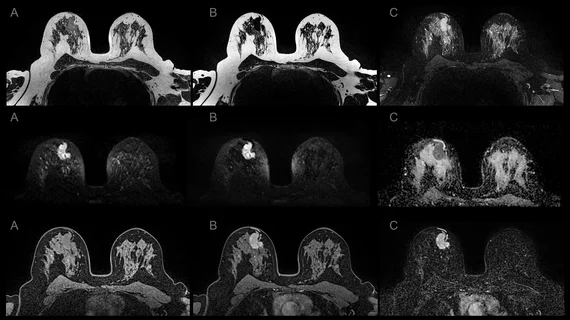MRI is the superior modality for supplemental imaging of women with dense breast tissue, according to a new meta-analysis.
The analysis included cases of more than 250,000 women who had been screened for breast cancer, more than half of whom were reported to have dense breast tissue and negative mammography screenings. A side-by-side comparison of digital breast tomosynthesis, handheld US, automated breast US and MRI scans in the non-high-risk cohort with dense breasts revealed MRI to be the superior modality in terms of cancer detection rates.
Due to the masking effect of dense breasts, women with this kind of tissue are more likely to have their cancer missed on standard mammographic screenings. Given that roughly 47% of women in the United States have dense breasts, and that this quality also comes with its own additional cancer risks, there is a great need to understand which supplemental imaging modality would benefit these women the most, experts involved in the new analysis indicated.
“Breast cancer masses appear white on a mammogram, and dense tissue also appears white, which makes finding breast cancers within dense breast tissue harder for radiologists,” explained study co-author Vivianne Freitas, MD, M.Sc., assistant professor at the University of Toronto. “Our study was designed to evaluate the role of different supplementary screening tests in women of average or intermediate risk of breast cancer with dense breast tissue who had a negative screening mammogram.”
Of the 132,166 patients with dense breasts and negative screenings included in the analysis, 541 breast cancers were initially missed but later detected on supplemental imaging exams. Experts found that cancer detection rates for breast MRI were “far superior” in comparison to the other three modalities studied and could detect even the smallest of lesions.
Freitas, who is also a staff radiologist at the Joint Department of Medical Imaging in Toronto, suggested that these results could help to better inform guidelines relative to supplementary screening in women with dense breast tissue to ensure that they are able to receive appropriate care and avoid delayed or missed diagnoses.
“Our results about the role of MRI in supplementary screening will allow stakeholders to guide healthcare policies in this setting and direct further research,” the doctor noted.
However, there is more work to be done before breast MRI can become the reference standard for dense breast imaging, Freitas indicated, adding that the accessibility and costs of the exam are barriers that must be overcome before widespread implementation can occur.
She suggested that future work is needed to assess the cost-effectiveness of the modality, in addition to its impact on mortality rates.
The study abstract is available in Radiology.

